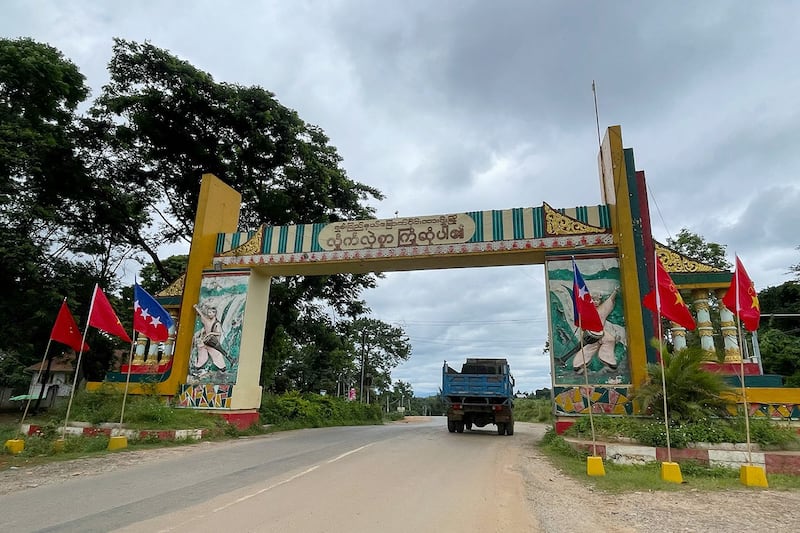Read RFA coverage of these topics in Burmese.
A year after its launch, the ethnic rebel alliance that spearheaded the Operation 1027 offensive in Myanmar‘s northern Shan state has said it will not rest until the country’s military regime is removed from power.
Since launching the offensive, named for its Oct. 27 start date, the Three Brotherhood Alliance of ethnic armies has gone on to push back the military from several regions in Shan state it controlled following its February 2021 coup d’etat, including along northeastern Myanmar’s border with China.
At the time of the launch, the alliance - made up of the Ta’ang National Liberation Army, the Myanmar National Democratic Alliance Army and the Arakan Army - said the objectives of the offensive included removing the junta from power, protecting the lives of the people, controlling more territory, preventing junta artillery and airstrikes, and suppressing online fraud gangs.
On Monday, Lway Yay Oo, the spokesperson for the Ta‘ang National Liberation Army, or TNLA, told RFA Burmese that the operation will continue until Myanmar‘s military regime steps down, calling it the offensive’s “first priority.”
“We are trying to form an interim revolutionary government together with the people in 2025,” she added.

The Three Brotherhood Alliance captured a total of 16 townships in northern Shan state between October 2023 and January 2024 as part of the first round of Operation 1027, before China mediated a suspension in fighting.
However, in late June the alliance launched a second round of the offensive, capturing Lashio city, where the junta’s Northeast Military Command headquarters was located, Kyaukme township which was also the base of the junta’s No. 1 Military Operations Command, and Nawnghkio township, as well as Mogoke township in neighboring Mandalay region.
Fighting experience
Other rebel groups who fought alongside alliance members told RFA that Operation 1027 had provided critical experience for their troops, as they continue to battle the junta in their own territories.
“We have gained knowledge of how much we need to strengthen our capacities to knock down the enemy, and how we should build our force,” said Aung Kyaw Myo Thant, the Chief Commander of the Generation Z Army, which conducted joint operations with the Arakan Army, or AA, during the offensive.
“In the past, we could not fight effectively in our area,” he said. “Now, these experiences have guided us in how to occupy more territory.”
RELATED STORIES
Insurgent army tightens its grip on northern Myanmar town
China border restrictions prompts pricing surge in Myanmar
Traders in Myanmar struggle as borders with China remain closed in rebel-held areas
Fighting in northern Shan state has unsettled Beijing, which in August launched its fourth military exercise along its border with Myanmar and has called on rebel groups to end hostilities with the junta.
While Chinese pressure has cooled tensions in the region, political commentator Than Soe Naing told RFA he expects the fighting to continue.
“Meanwhile, other rebel offensives are underway in other areas of the country,” he said. “The goals of these offensives all end in Naypyidaw,” he added, referring to Myanmar‘s capital city and the junta’s base of power.
Border restrictions cause shortages
The anniversary of Operation 1027 comes as residents reported that China’s border closures and restrictions on goods as part of its bid to pressure ethnic rebels into a ceasefire with the junta has led to shortages of fuel and food in northern Shan state and neighboring Kachin state.
Beginning Oct. 22, China banned the transport of electrical equipment, building materials and mobile phones through the Kyalgaung gate, which separates Shan state’s Muse township from China’s Dehong Dai and Jingpo Autonomous Prefecture in Yunnan province. Another gate serving the area was closed off entirely in July.
Since the start of Operation 1027, the junta has blocked the transportation of fuel, rice, food, and medicine from Myanmar’s heartland to cities in northern Shan state, forcing residents to rely primarily on supplies from China. Residents said that the situation has worsened amid the recent border restrictions.

A resident of Shan state’s Namhkam township, where China closed its side of the border crossing on July 9, said there is an acute fuel shortage in the area, and that prices “have skyrocketed.”
“In Namhkam, some shops have stopped selling gasoline and diesel altogether,” said the resident who, like others interviewed for this report, spoke to RFA on condition of anonymity due to security concerns. “Previously, people used to travel by motorcycle, but now many are forced to walk. If China continues to restrict oil imports, Muse and Namhkam could be completely without fuel in the future.”
Only two of the five gas stations in Namhkam are open, residents said, adding that the neighboring townships of Muse, Mongko and Pangsang are also facing a fuel shortage, which has led to an increase in the prices of food items.
Transport challenges and price spikes
An official from an aid organization in Muse told RFA that the shortage is causing significant hardship for the region.
“Many are unsure how to resolve this issue, and some gasoline stations have shut down sales entirely,” said the official, who also declined to be named. “Prices have also soared, increasing from 4,500 kyats (US$1) per liter to 9,000 kyats (US$2) per liter [since the restrictions]. This situation is proving difficult for everyone who relies on gasoline.”

Other sources told RFA that in Kachin state, where on Oct. 19 Chinese authorities closed several border crossings for renovations and upgrades to inspection systems, residents are facing food shortages and price surges due to transportation difficulties.
Attempts by RFA to contact the Chinese Embassy in Myanmar for comment on the situation have gone unanswered, as have efforts to reach junta spokesperson Major General Zaw Min Htun.
Translated by Aung Naing and Kalyar Lwin. Edited by Joshua Lipes and Matt Reed.
